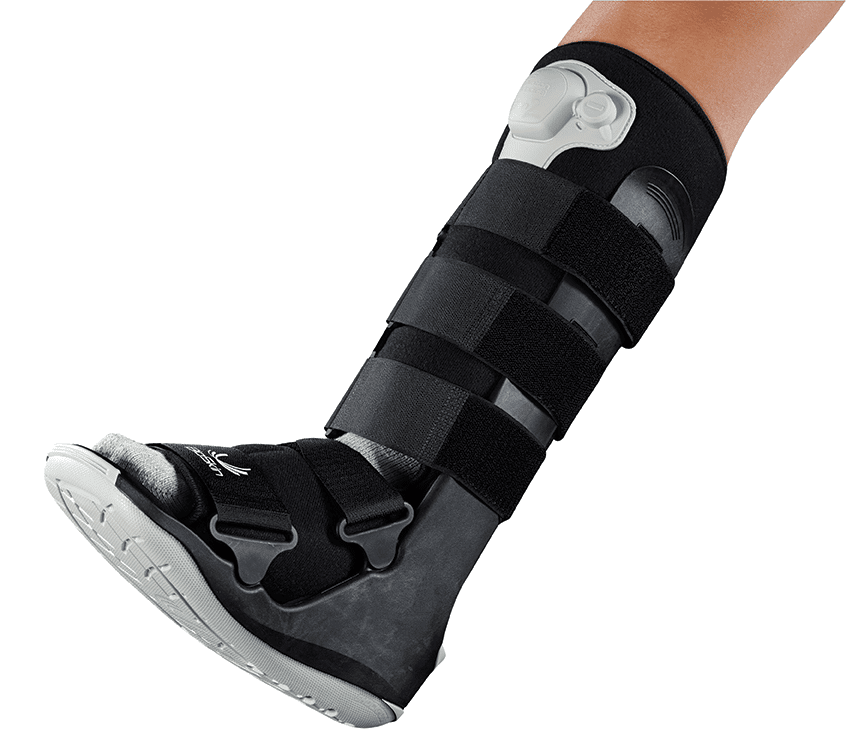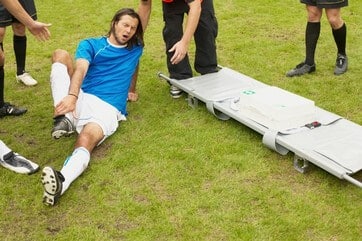4 Walking Boot Questions & Answers
A walking boot, also known as a walking brace, is a special type of medical footwear that doctors use to protect the foot and ankle areas after the patient has experienced an injury or after a surgical intervention in these areas. The primary goal of these shoes is to stabilize the foot and allow it to heal. It can also redistribute weight bearing pressure from one part of the foot to another. The reduced pressure gives an opportunity to heal more quickly. In this post we cover 4 of the most common walking boot questions from individuals who are preparing to start wearing this type of footwear, and provide some suggested answers.
The specific injuries for which a walking brace may be recommended include stress fractures or other fractures of the shin, foot & ankle. Health professionals can also effectively treat ankle sprains, injuries to the achilles or torn calf muscles using a walking boot. In addition, your doctor may suggest wearing one if you are suffering from shin splints.
Walking Boot Taxonomy
Walking boots can be either tall or short. The tall version can extend as far as the knee while the short boot may perhaps only reach halfway between the foot and knee. The tall version is more effective at immobilizing the lower foot muscles but may also be less comfortable to wear, particularly for shorter individuals. The shorter version provides greater wearing comfort and is generally easier to walk in, but will also generally provide less support and stabilization of the foot and lower ankle.
Another important classification of walking boots is pneumatic vs. non pneumatic. Pneumatic boots use compressed air to inflate the lining of the boot and provide additional support and compression to the foot. The effect of this compression is better control of any inflammation that may be present, as well as greater relief from pain.
Non pneumatic boots, on the other hand, do not use air and are more similar to a cast boot. They will not provide the compression and pain relief of their pneumatic counterparts but they are a more affordable option.
In most cases your doctor will decide which of these alternatives (pneumatic or non pneumatic, tall or short) is better for you in light of your particular injury and other circumstances.
Walking Boot Questions
Should I wear my walking boot to bed?
This is one of the most common walking boot questions among patients who are just starting to wear one. Although you should follow your doctor’s advice in any situation, the normal practice is to wear the boot while sleeping. However, loosening the straps that secure the boot will increase wearing comfort and allow you to sleep better.
Another good tip on a related subject is to sleep with pillows surrounding the boot in order to support the foot and avoid its displacement. It will also cushion the foot against any external impacts that may aggravate the injury.
If you wear the boot throughout the day and are concerned about keeping your bedclothes clean, you could surround your foot with an old pillow that you do not need to use anymore. This will provide support and protection while maintaining hygiene.
Can I drive while wearing my walking brace?
This is another commonly asked walking boot question. In general while wearing a walking boot on the left foot is generally permissible, studies have shown that wearing one (or other similar types of footwear) on the right foot can adversely affect driving performance. In particular, a 2016 study by the Journal of Foot & Ankle Surgery found that patients wearing a walking boot on the right foot exhibited significantly slower braking response times compared to individuals not wearing such a device. The study also found that patients wearing a walking boot tended to simultaneously press both accelerator and brake while driving. In general, the impaired neuromuscular control from which patients who are wearing a boot may be suffering will make it more difficult for them to quickly and accurately find the correct pedal in emergency situations.
Conclusion: although you should always follow the guidance of your doctor, the normal recommendation in response to this walking boot question is to avoid driving while wearing one if you would have to wear it on your right foot.
Should I use crutches while wearing the walking boot?
In some cases, doctors may advise their patients not to place any weight on the foot while wearing the shoe. These patients will need to continually use crutches to keep weight off the foot. In particular, if the patient will not be wearing the boot to bed, he or she should be careful to keep the crutches by the bedside and in easy reach. This will reduce the risk that the patient may accidentally place weight on the foot while getting into or getting up from bed.
Should I wear the boot while showering?
The priority should be to avoid putting weight on the unprotected foot at any time, as this could aggravate the injury. If you are not comfortable wearing the boot in the shower, one suggested approach for bathing is to remove the boot and sit on a chair in the shower in order to take the weight off the foot. Alternatively, if you would prefer to leave the boot on while showering, you could keep it dry by covering it with a plastic bag and using adhesive tape to create an airtight seal.
Conclusion
In this post, we have examined 4 common walking boot questions from patients preparing to wear this type of footwear for a period. Although the suggestions above will probably be appropriate for most of the patients who are about to start wearing a boot, we would (as always) suggest following your doctor’s advice in order to ensure that your treatment proceeds as intended.








I had a surgery on cyst removed from ankle joint had to regrow bone there. Wore the boot for 6 weeks after 2 weeks non weight baring and it was actually 2-3” longer then my foot so it rocked beyond my toes to bend. Now boot is off and on left foot the last 3 toes on outside of foot are extremely painful in the toes and the ball of the foot. Is this normal and how do I treat it for the pain. Thank you.
I do not think it is normal for you to have pain in your foot after removal of the boot. It sounds as though the boot was not fitting you properly. If you have just pain without inflammation or infection, then this should settle with painkillers like paracetamol (Tylenol) and ibuprofen (Advil). However, if there is inflammation or infection or you are not sure, then you should see your family doctor. This is because you will need a prescription for a steroid cream or ointment or an antibiotic by mouth. The prescription can only be issued by a family doctor (only very mild steroid cream/ointment can be purchased over the counter).
Hi, what is the best way to wash internal lining part? I’m scared it will shrink in washing machine or in the dryer?
Hello – to be on the safe side, we would suggest hand washing with water and a mild soap and then allowing to air dry. Avoid machine washing and electric/gas dryers.
Thanks.
I have a fractured Tibula and fibula I am in a splint what kind of walking boot would I wear
I think what boot you should wear would depend on which of the two versions would be more compatible with the splint you are wearing. Does the tall or the short one fit better and which is more comfortable? The tall version immobilises the foot better but costs more. The pneumatic version controls the pain better but costs more. You will need to weigh up the pros against the cons of each version and decide what is more important to you. Then you can make your decision taking into consideration how much you are prepared to spend. I hope this advice is what you were looking for.
Hello Yvonne: If you have fractured your tibia & fibula, you would probably be better off with a tall boot, especially if the fractures are higher up on the lower leg. The short boot would probably not provide stabilization where you need it.
However, as with everything else, we strongly recommend confirming this with your doctor before taking any actions. Thanks.